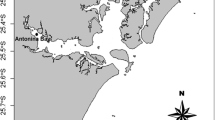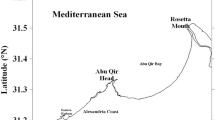Abstract
The present research reports the heavy metal (Fe, Cr, Pb, As, and Co) contamination in caviar of Persian sturgeon (Acipenser persicus) caught from Southern Caspian Sea sampling site using ICP-OES. Heavy metal concentrations (microgram per gram, wet weight; means ± S.D.) in caviar samples were: Fe, 71.33 ± 0. 37; Cr, 0.27 ± 0.019; Pb, <0.01 ± 0.002; As, <0.01 ± 0.002; and Co, <0.01 ± 0.001, respectively. Comparative evaluation of these metals in different samples showed that except Fe, the average concentrations of Cr, Pb, As, and Co are significantly lower than adverse level for the species themselves and for human consumption when compared with FAO/WHO permissible limits. Therefore, their contribution to adverse health effects on human body can be considered as negligibly small.

Similar content being viewed by others
References
Abou-Arab AAK, Ayesh AM, Amra HA, Naguib K (1996) Characteristic levels of some pesticides and heavy metals in imported fish. Food Chem 57:487–492
Adekunle IM, Akinyemi MF (2004) Lead levels of certain consumer products in Nigeria: a case study of smoked fish foods from Abeokuta. Food Chem Toxicol 42:1463–1468
Agusa T, Kunito T, Tanabe SH, Pourkazemi M, Aubrey DG (2004) Concentrations of trace elements in muscle of sturgeons in the Caspian Sea. Mar Pollut Bull 49:789–800
Anan Y, Kunito T, Ikemoto T, Kubota R, Watanabe I, Tanabe S, Miyazaki N, Petrov EA (2002) Elevated concentrations of trace elements in Caspian seals (Phoca caspica) found stranded during the mass mortality events in 2000. Arch Environ Contam Toxicol 42:354–362
Anonymous (2003) Joint FAO/WHO expert committee on food additives, Sixty-first Meeting Rome, June 10–19
Ashraf W, Seddigi A, Abulkibash A, Khalid M (2006) Levels of selected metals in canned fish consumed in Kingdom of Saudi Arabia. Environ Monit Assess 117:271–279
Aucoin J, Blanchard R, Billiot C (1999) Trace metals in fish and sediments from Lake Boeuf, South Eastern Louisiana. Microchem J 62:299–307
Barandier C, Tanguy S, Pucheu S, Boucher F, De-Leiris J (1999) Effect of antioxidant trace elements on the response of cardiac tissue to oxidative stress. Ann N Y Acad Sci 874:138–155
Billard R, Lecointre G (2001) Biology and conservation of sturgeon and paddle fish. Rev Fish Biol Fisher 10:355–392
Boadi NO, Twumasi SK, Badu M, Osei I (2011) Heavy metal contamination in canned fish marketed in Ghana. Am J Sci Indus Res 2(6):877–882
Canbek M, Temir AD, Mustafa U, Gokhan B, Ozgur E, Naime A (2007) Preliminary assessment of heavy metals in water and some cyprinidae species from the Porsuk River, Turkey. J Appl Biol Sci 1(3):91–95
Castro-González MI, Méndez-Armenta M (2008) Heavy metals: implications associated to fish consumption. Environ Toxicol Pharmacol 26:263–271
Dahiya S, Karpe R, Hegde AG, Sharma RM (2005) Lead, cadmium and nickel in chocolate and candies from suburban areas of Mumbai. India, J Food Comp Anal 18:517–522
De-Lorgeril M, Salen P, Accominotti M, Cadau M, Steghens JP, Boucher F (2001) Dietary and blood antioxidants in patients with chronic heart failure Insights into the potential importance of selenium in heart failure. Eur J Heart Failure 3(6):661–669
Dumont HJ (1998) The Caspian Lake: history, biota, structure, and function. Limnol Oceanogr 43:44–52
Evans DW, Dedoo DK, Hanson PJ (1993) Trace element concentrations in fish livers Implications of variations with fish size in pollution monitoring. Mar Pollut Bull 26(6):329–334
Food and Agricultural Organization of the United Nations and World Health Organization (FAO/WHO) (1984) List of maximum levels recommended for contaminations by the joint FAO/WHO Codex Alimentarius Commission, Second Series CAC/FAL, Rome, 3:1–8
Food and Agricultural Organization of the United Nations and World Health Organization (FAO/WHO) (2009) Codex general standard for food additives. Codex standards 192–1995:259
Goyer RA (1991) Toxic effects of metals. In: Amdur MO, Douli J, Klansmen CD (eds) Caserrett and Doull’s toxicology: the basic science of poisons, 4th edn. Pergamon, New York, pp 623–680
Hellawell JM (1986) Biological indicators of freshwater pollution and environmental management. Elsevier, Amsterdam, pp 546–554
Heidary S, Imanpour Namin J, Monsefrad F (2012) Bioaccumulation of heavy metals Cu, Zn, and Hg in muscles and liver of the stellate sturgeon (Acipenser stellatus) in the Caspian Sea and their correlation with growth parameters. Iran J Fish Sci 11(2):325–337
Hosseini SM, Sobhanardakani S, Batebi Navaeic M, Kariminasab M, Aghilinejad SM, Regenstein JM (2013) Metal content in caviar of wild Persian sturgeon from the southern Caspian Sea. Environ Sci Pollut Res. doi:10.1007/s11356-013-1598-9
Ikem A, Egeibor NO (2005) Assessment of trace elements in canned fishes (mackerel, tuna, salmon, sardines and herrings) marketed in Georgia and Alabama (United States of America). J Food Comp Anal 18:771–787
Institute of Medicine (2003) Dietary References Intakes: Applications in dietary planning. Subcommittee on interpretation and uses of dietary reference intakes and the standing committee on the scientific evaluation of dietary reference intakes. Institute of Medicine of the National Academies, The National Academies Press, Washington, DC, pp 248
IUCN (2012) Sturgeon more critically endangered than any other group of species. Press release 28 December 2012. IUCN, Gland
Iwegbue CMA, Nwajei GE, Arimoro FO, Eguavoen O (2009) Characteristic levels of heavy metals in canned sardines consumed in Nigeria. Environmentalist 29:431–435
Khansari FE, Ghazi-Khansari M, Abdollahi M (2005) Heavy metals content of canned tuna fish. Food Chem 93:293–296
Mashroofeh A, Riyahi Bakhtiari A, Pourkazemi M (2012) Bioaccumulation of Zn, Cu and Mn in the Caviar and Muscle of Persian sturgeon (Acipenser persicus) from the Caspian Sea, Iran. Bull Environ Contam Toxicol 89(6):1201–1204
Mashroofeh A, Riyahi Bakhtiari A, Pourkazemi M, Rasouli S (2013) Bioaccumulation of Cd, Pb and Zn in the edible and inedible tissues of three sturgeon species in the Iranian coastline of the Caspian Sea. Chemosphere 90(2):573–580
Mertz W (1981) The essential trace elements. Sci 213:1332
Mol S (2011) Levels of heavy metals in canned bonito, sardines, and mackerel produced in Turkey. Biol Trace Elem Res 143:974–982
Mol S (2011) Levels of selected trace metals in canned tuna fish produced in Turkey. J Food Comp Anal 24:66–69
Mol S (2011) Determination of trace metals in canned anchovies and canned rainbow trouts. Food Chem Toxicol 49(2):348–351
Muñoz O, Devesa V, Suñer M, Ve’lez D, Montoro R, Urieta I, Macho M, Jaloñ M (2000) Total and inorganic arsenic in fresh and processed fish products. J Agric Food Chem 48(9):4369–4376
Nair M, Jayalakshmy KV, Balachandran KK, Joseph T (2006) Bioaccumulation of toxic metals by fish in a semi-enclosed tropical ecosystem. Environ Forensics 7:197–206
Oehlenschläger J (2005) Identifying heavy metals in fish. In: Bremner HA (ed) Safety and quality issues in fish processing. Woodhead, Cambridge, pp 95–108
Olgunoğlu IA, Olgunoğlu MP (2011) Concentrations of metal contaminants, vitamin and mineral in waxed caviar from Mugil cephalus (L., 1758). Afric J Agric Res 6(4):1041–1046
Ordiano-Flores A, Galván-Magaña F, Rosiles-Martínez R (2011) Bioaccumulation of Mercury in Muscle Tissue of yellowfin tuna, Thunnus albacares, of the Eastern Pacific Ocean. Biol Trace Elem Res 144(1–3):606–620
Ponka P, Tenenbein M, Eaton JW (2007) Iron (3rd ed.). In: Nordberg GF, Fowler BA, Nordberg M, Friberg LT, Editors, Handbook on the Toxicology of Metals. 30, Academic Press, pp 577–598
Pourang N, Tanabe S, Rezvani S, Dennis JH (2005) Trace elements accumulation in edible tissues of five sturgeon species from the Caspian Sea. Environ Monit Assess 100:89–108
Rajeshkumar S, Munuswamy N (2011) Impact of metals on histopathology and expression of HSP 70 in different tissues of Milk fish (Chanos chanos) of Kaattuppalli Island, South East Coast, India. Chemosphere 83:415–421
Rashed MN (2001) Monitoring of environmental heavy metals in fish from Nasser Lake. Environ Int 27:27–33
Salehifar E, Shokrzadeh M, Ghaemian A, Aliakbari S, Saeedi Saravi SS (2008) The study of Cu and Zn serum levels in idiopathic dilated cardiomyopathy (IDCMP) patients and its comparison with healthy volunteers. Biol Trace Elem Res 125(2):97–108
Shokrzadeh M, Ghaemian A, Salehifar E, Aliakbari S, Saeedi Saravi SS, Ebrahimi P (2009) Serum zinc and copper levels in ischemic cardiomyopathy. Biol Trace Elem Res 127(2):116–123
Sobhanardakani S, Tayebi L, Farmany A (2011) Toxic metal (Pb, Hg and As) contamination of muscle, gill and liver tissues of Otolithes rubber, Pampus argenteus, Parastromateus niger, Scomberomorus commerson and Onchorynchus mykiss. World Appl Sci J 14:1453–1456
Tarley CRT, Coltro WKT, Matsushita M, de Souza NE (2001) Characteristic levels of some heavy metals from Brazilian canned sardines (Sardinella brasiliensis). J Food Comp Anal 14:611–617
Tabari S, Saeedi Saravi SS, Bandany GA, Dehghan A, Shokrzadeh M (2010) Heavy metals (Zn, Pb, Cd and Cr) in fish, water and sediments sampled form Southern Caspian Sea, Iran. Toxicol Ind Health 26(10):649–656
Topuzoglu G, Erbay AR, Karul AB, Yensel N (2003) Concentrations of copper, zinc, and magnesium in sera from patients with idiopathic dilated cardiomyopathy. Biol Trace Elem Res 95(1):7–11
USFDA (2001) Fish and Fisheries Products Hazards and Controls Guidance, U.S. Food and Drug Administration, Center for Food Safety & Applied Nutrition, Chapter 9, Environmental chemical contaminants and pesticides, pp 26
Wang W, Batterman S, Chernyak S, Nriagu J (2008) Concentrations and risks of organic and metal contaminants in Eurasian caviar. Ecotoxicol Environ Safe 71:138–148
World Health Organization (WHO) (1996) Health criteria other supporting information, guidelines for drinking water quality, 2nd edn. WHO, Geneva, pp 318–388
Yasunaga G, Watanabe I, Prudente MS, Suburamanian A, Qui V, Tanabe S (2000) Trace elements accumulation in waders from Asia. Toxicol Environ Chem 77:75–92
Author information
Authors and Affiliations
Corresponding author
Rights and permissions
About this article
Cite this article
Hosseini, S.V., Sobhanardakani, S., Tahergorabi, R. et al. Selected Heavy Metals Analysis of Persian Sturgeon’s (Acipenser persicus) Caviar from Southern Caspian Sea. Biol Trace Elem Res 154, 357–362 (2013). https://doi.org/10.1007/s12011-013-9740-6
Received:
Accepted:
Published:
Issue Date:
DOI: https://doi.org/10.1007/s12011-013-9740-6




